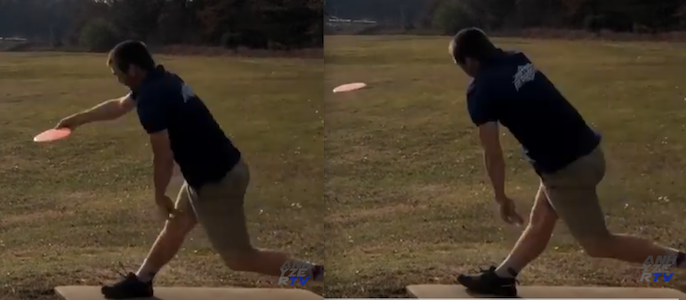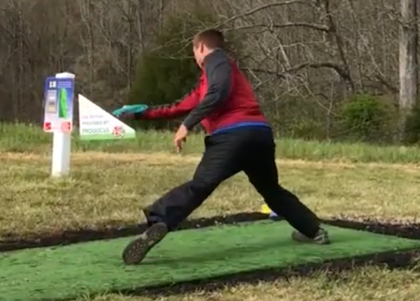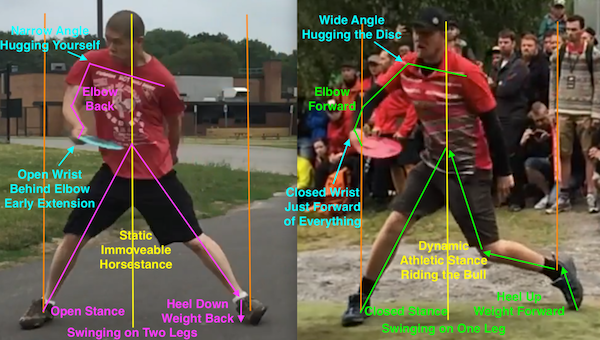UhhNegative
Eagle Member
- Joined
- Mar 28, 2016
- Messages
- 950
Conrad is anything but effortless looking when he throws.
Discover new ways to elevate your game with the updated DGCourseReview app!
It's entirely free and enhanced with features shaped by user feedback to ensure your best experience on the course. (App Store or Google Play)
In the Jones case it appears the little kick is to signal a firing of the adductors to turn the hips toward the target/flight line; simultaneously locking the core with the left shoulder to stay in rotation with the hip. Just my conjecture.
Agree the force comes from the ground up. The torque is the byproduct of leverage/increasing the T-handle length increases leverage on it/or the disc, so when you swing on one-leg the increased torque is released into the ground and the disc, instead of the torque remaining in the body/levers when you swing on two-legs weighted to the ground. The body is more like a "X-handle" than "T-handle", but when the rear foot leaves the ground before the swing, it becomes the "T-handle"(One Leg/Feet Together Drill) with the rear leg and arm countering the release of the swing making the T-handle leverage longer, instead of torquing into the ground through the body in a wide "X-handle" of the feet/weight stuck back.If you want to talk in terms of torque think T-handle wrench or keyed shaft. The arms then become an open ended three bar linkage with the shoulder girdle. Torque transmission must begin somewhere. I still posit that is at the feet. In the Jones case it appears the little kick is to signal a firing of the adductors to turn the hips toward the target/flight line; simultaneously locking the core with the left shoulder to stay in rotation with the hip. Just my conjecture.
I was talking about the need for me to develop my own vocabulary to describe what I need to describe. The first word I'm bringing to the conversation is the concept of the flap.
I'm a crazy engineer. Everybody's brains work and think in different ways, everything is a perception of our own brains. IMO there is no one absolute way to teach or think about the throw. When you are focused on a target, things can become perceived as straight even though the arc is obvious - like hammering a nail or using a battering ram (or tossing the weight of an object/disc), you want to pound the nail straight into a target, but to use the weight of the hammer you have to lever it from your body which creates an arc.
IMO Conrad actually has better footwork than Jones, but wouldn't recommend copying either as models. You can take parts of their form and make it into your own. Everybody has different body builds, and athletic ability and flexibility.And yet he is too 10. Hmmm... Yah, I would not copy Conrad.
Kevin Jones is my model.
Guess I should do a thread on why I will never throw like Kevin Jones, he is crazy young and athletic and IMO is not ideal model of efficient footwork, he takes a really long and fast x-step and low angulated hip stride into the plant, so he almost does the splits. His front knee appears to be snapping into hyperextension, OUCH!Let's return to the discussion of the new throwing method.
If You observe the Kevin Jones throw you can notice that his run-up serves to facilitate two main elements. The first thing is that he must create some forward momentum with the center of his Mass to facilitate a weight shift . His x step serves only to place his left side in behind his right side and he serves to crawl up sideways in his run-up with his eyes facing the target and his left side being pushed in behind is right. He is doing absolutely nothing with the disc and the throwing arm. He simply has his arm folded at the elbow and sitting in front of his chest.
Now to the critical part where he plants and prepares to launch his left side around his right. The first thing that happens is that the left foot plants at approximately 45 degrees open to his body. And with this plant he steps laterally with his right foot and plants is right foot approximately 45 Degrees open to his body. Then as the center of his Mass continues to move forward he spins his left foot from 45° open to 45 degrees closed and his foot leaves the ground.
I would submit that this particular part of the throw is the same type of horse stance you see in every athletic endeavor where the knees are bent and both feet are somewhat open an in athletic ready position. This facilitates the hip joints working. And the feet are working along the line of the shoulders Inward and outward. This takes the mystery out of the foot position for the plant of the left foot and the plant of the right foot. His feet are simply slightly open to his hips in both directions to facilitate hip rotation in both directions. To rotate on one hip or the other the center of gravity must shift to that side and the trailing foot lift



Brad, is the "generating power from the left side" similar to a hitter in baseball pivoting on his back leg?
Baseball players don't pivot on their back leg?
He's saying to experiment with using your left side/shoulder to position yourself. For example, when in the backswing take a momentary note of where your right shoulder is and imagine replacing it with your left shoulder. Once your left shoulder is in that place you should probably be near the hit point, hopefully with an extended arm, and get ready to unload that disc.